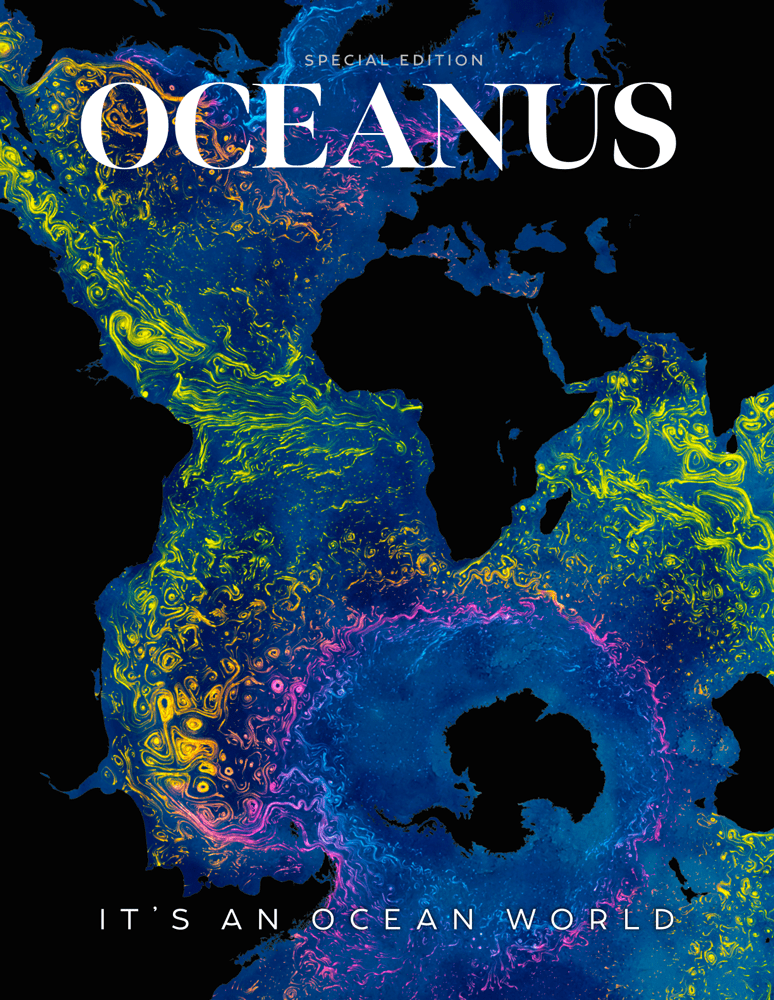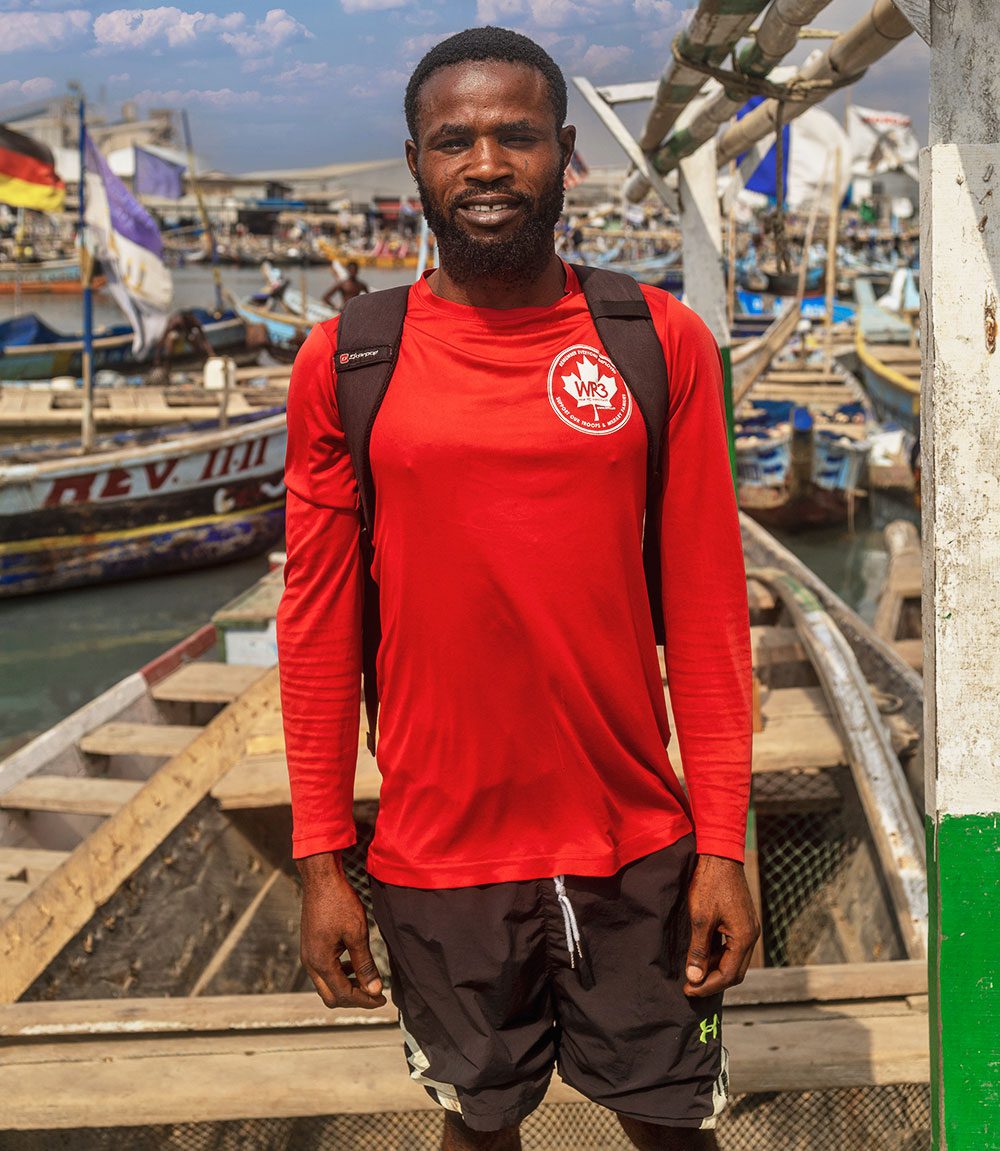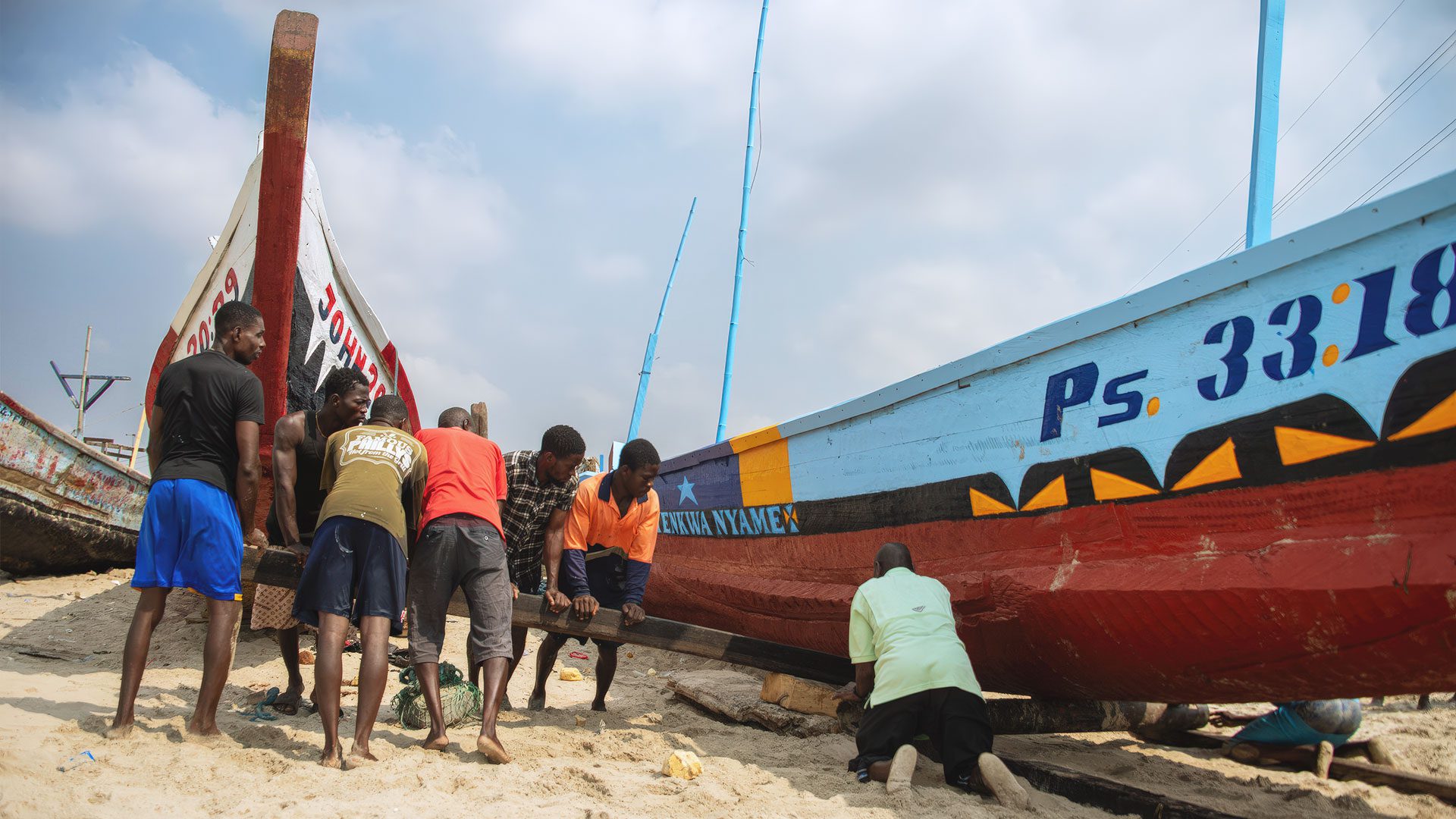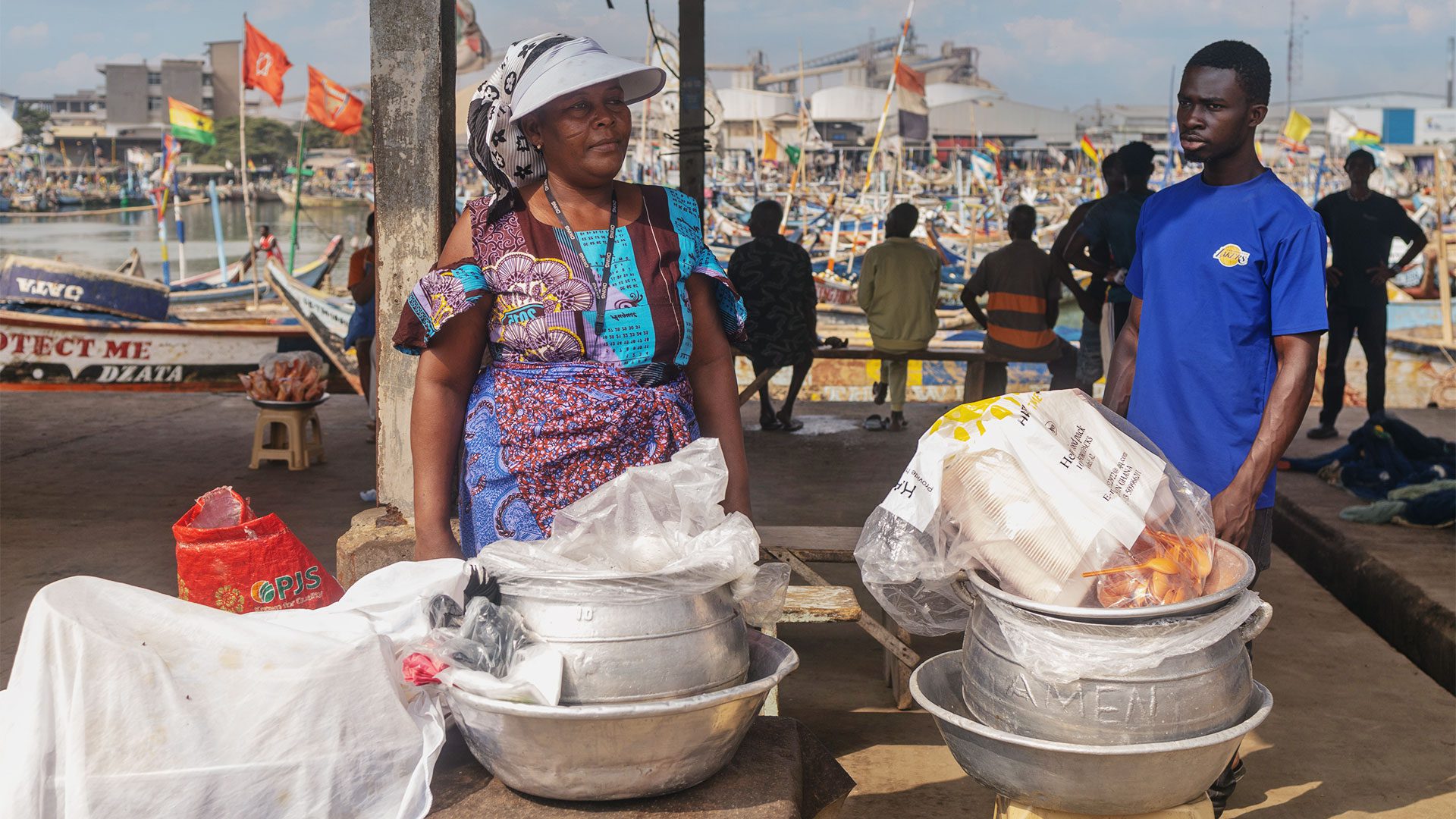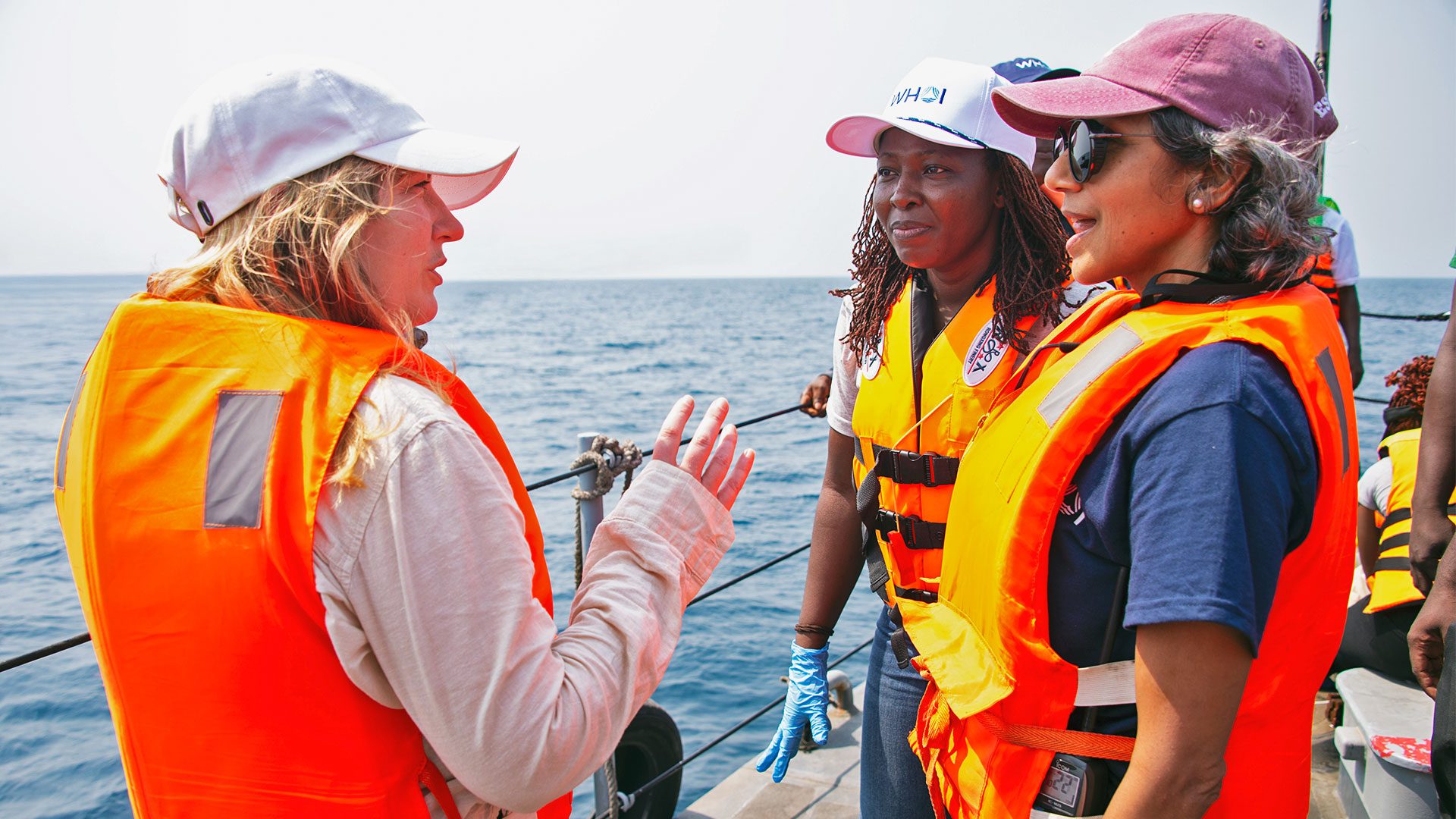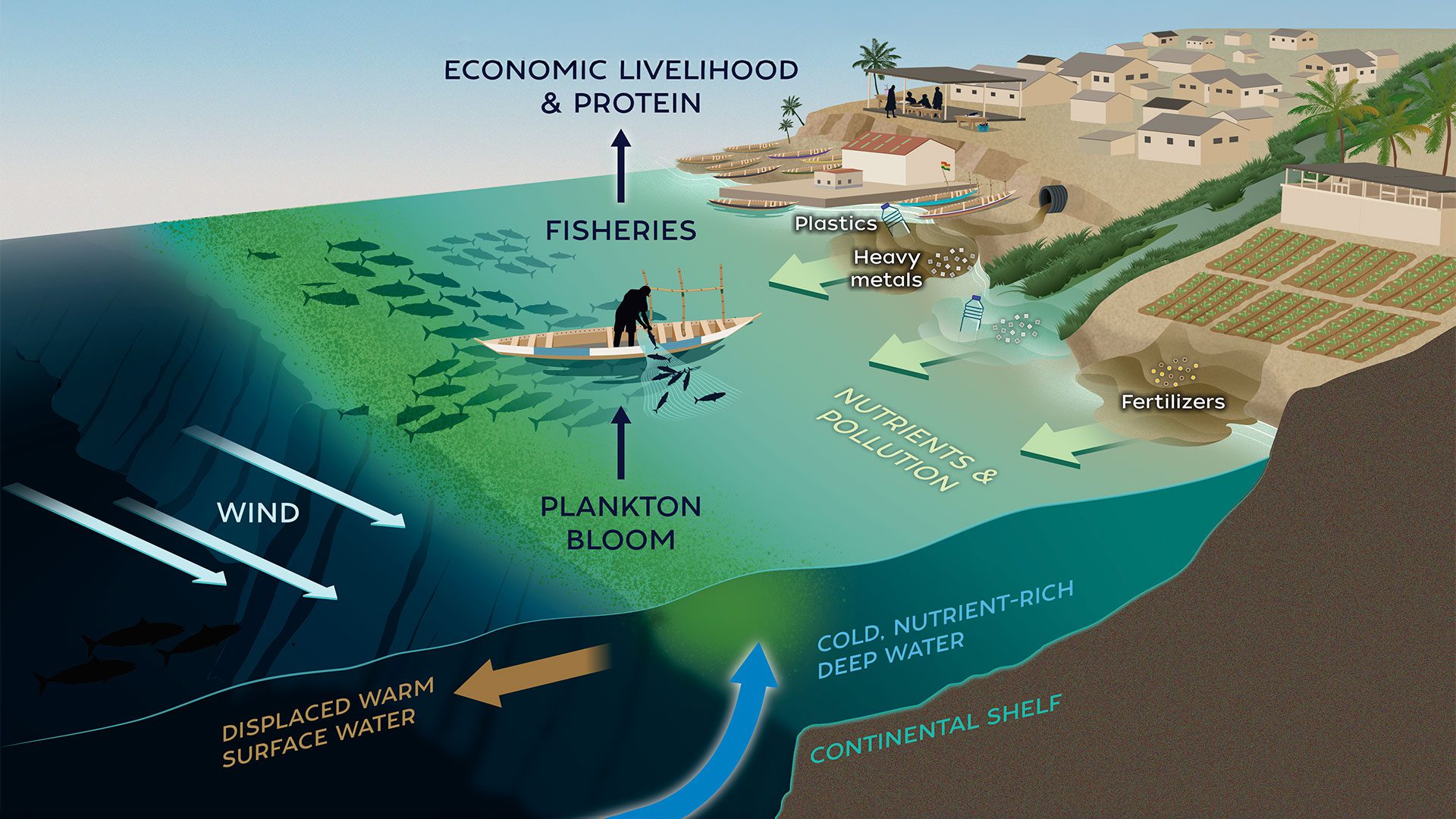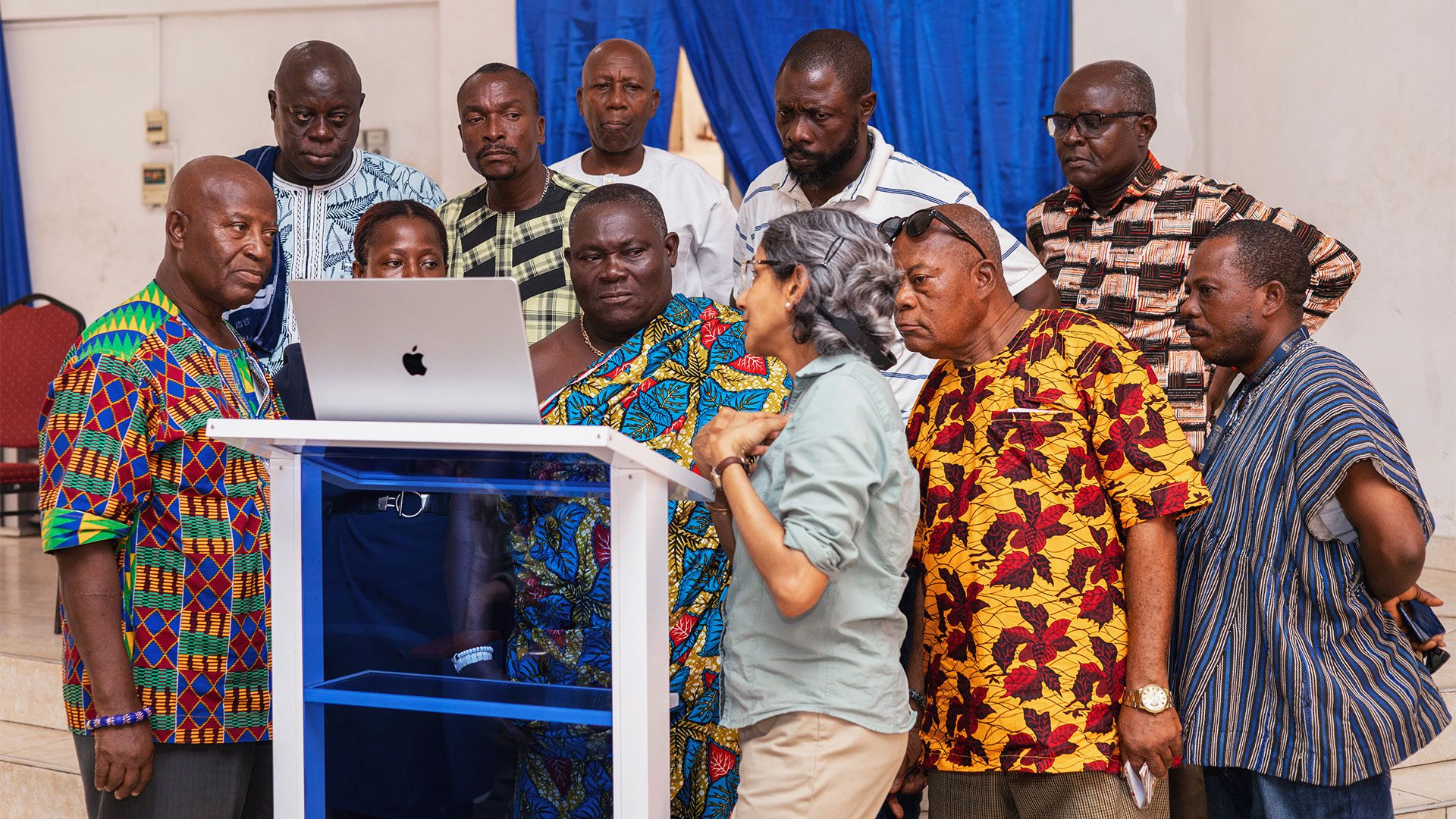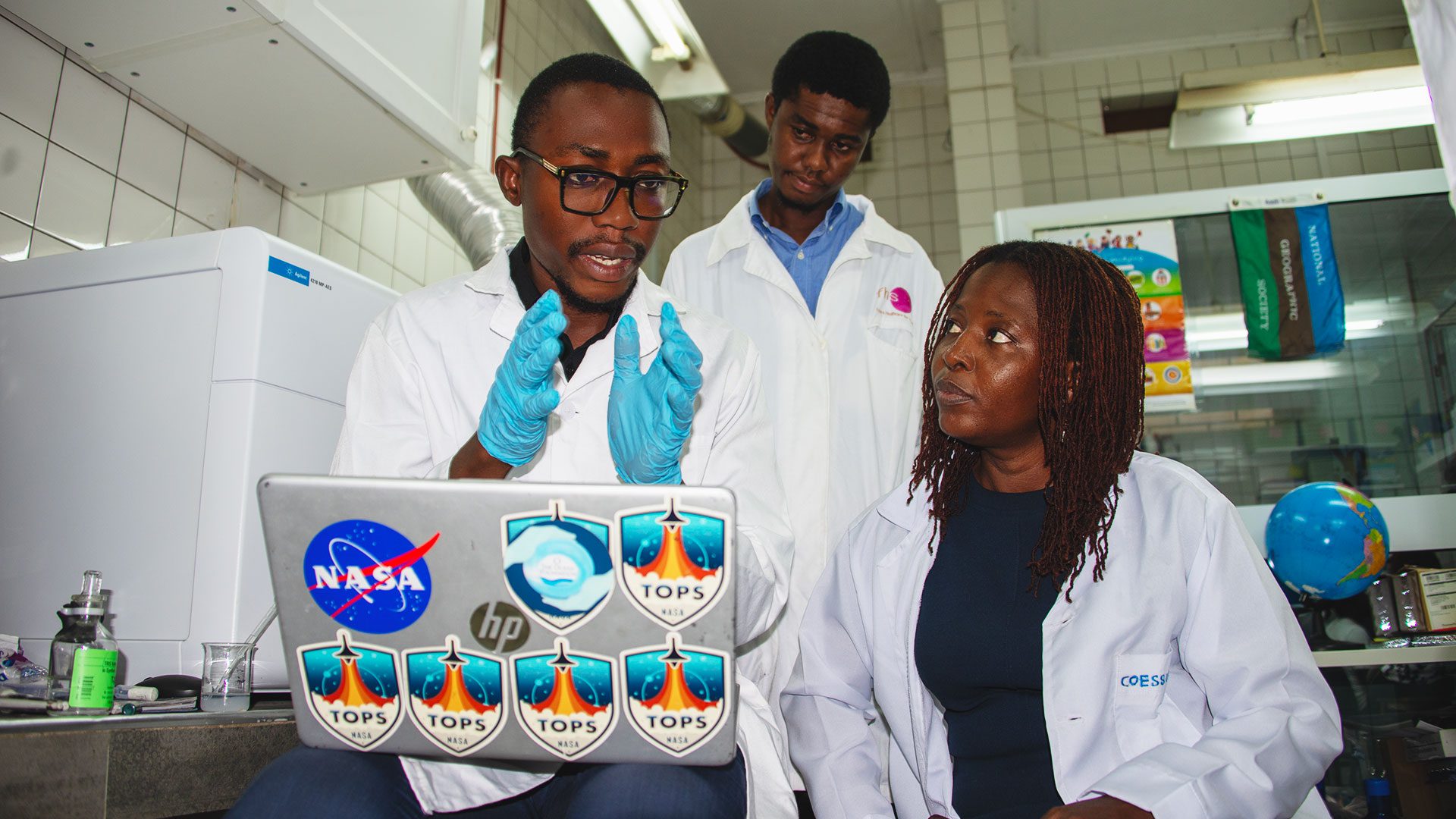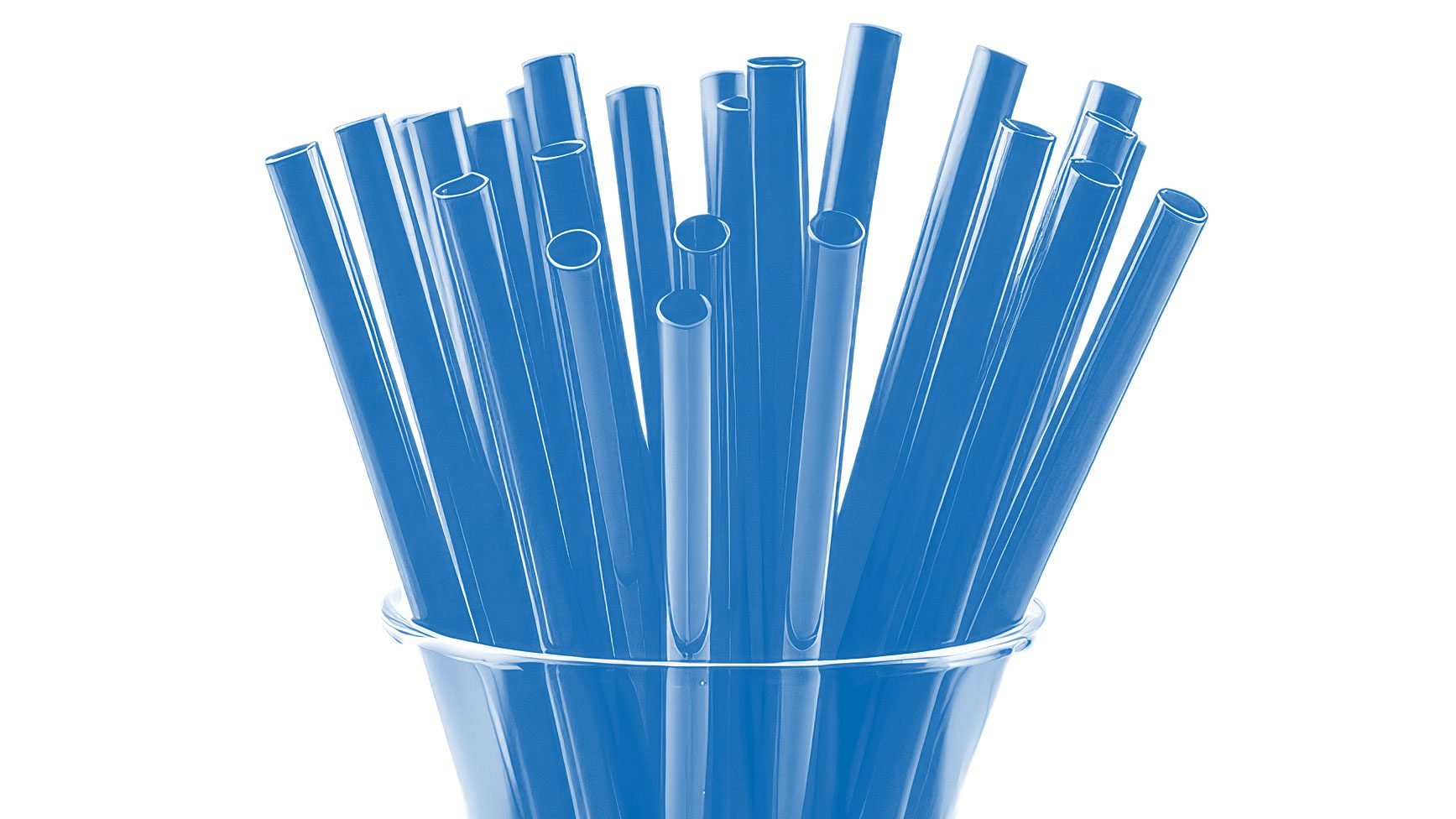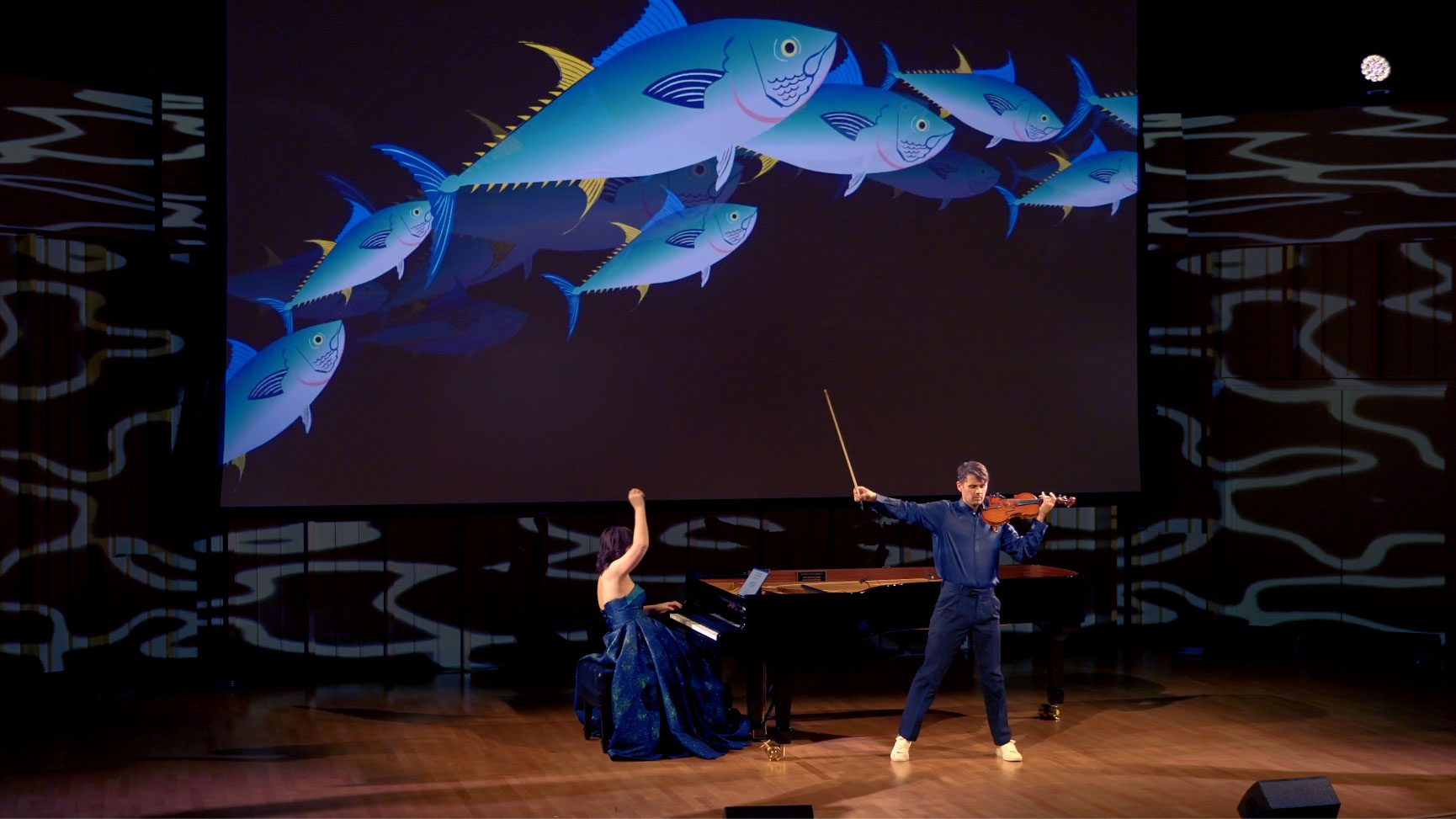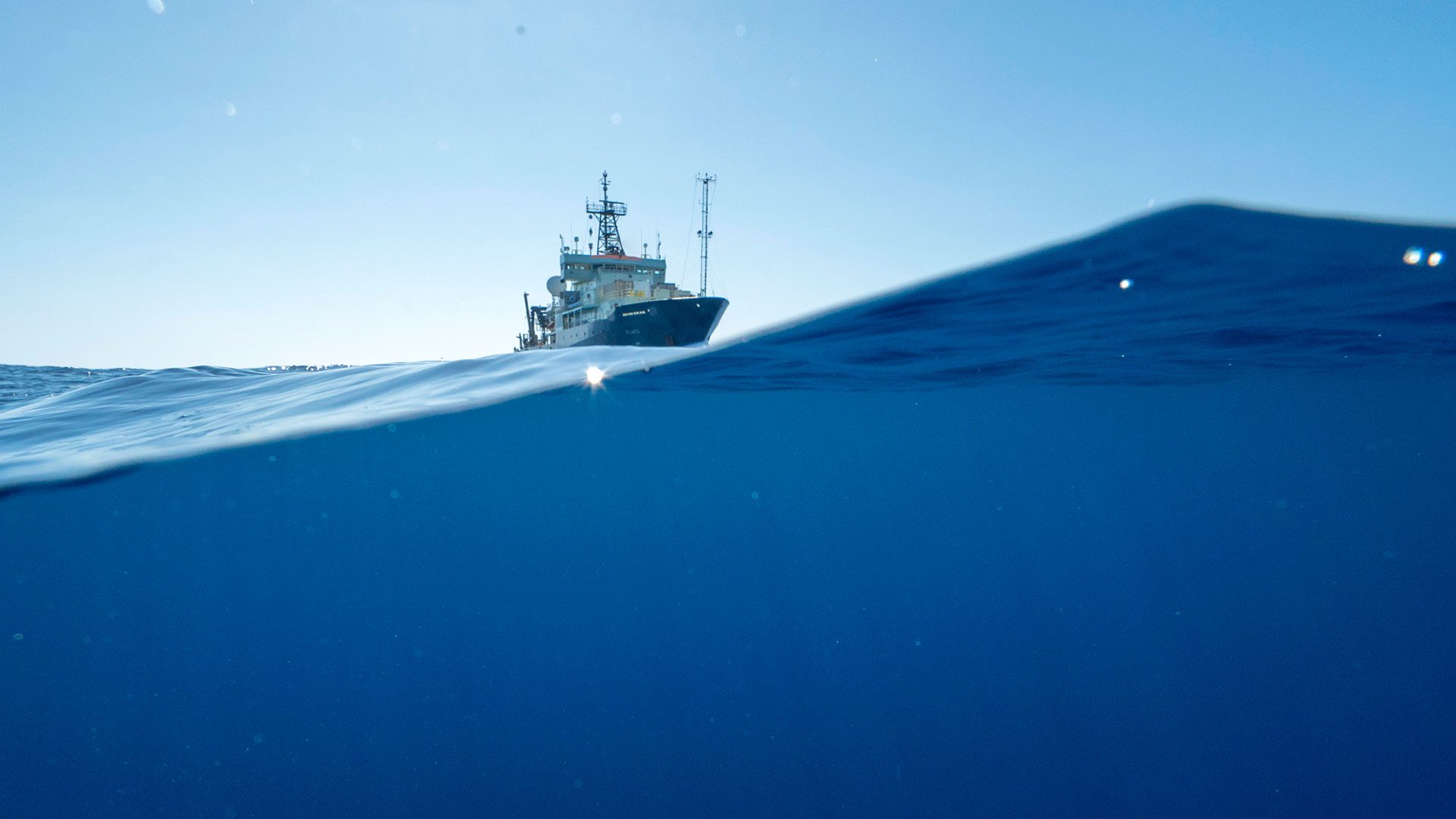Life at the margins
Investigating the connections between Ghana’s land, sea, and blue economy
Life at the margins
Investigating the connections between Ghana’s land, sea, and blue economy
BY ELISE HUGUS | MAY 27, 2025
The ocean breeze sends a sigh of relief through the sweltering fish market overlooking the Gulf of Guinea. As young boys play in the surf and men roll their brightly painted wooden canoes down the beach to the harbor, women in vibrant prints sell the day’s catch: thumb-sized anchovies and arm’s length barracuda, wide-eyed redfish and striped sea bream. Along the hazy horizon, cargo ships and Chinese fishing trawlers loom, dwarfing the fishermen in pickup-size canoes who haul nets by hand in the vain hope of finding them full.
In flip-flops and socks, Emmanuel Tego hoists himself onto a beached canoe and steps nimbly across the rocking wooden floats to his own boat, moored against the sand. Ever since he was a child, he has fished for mackerel and redfish off this coast, but things have changed now that he has children of his own.
“We don’t see the same fish abundance as we did then,” Tego said through an interpreter in his native Twi. “It’s hit and miss. If you don’t catch a lot of fish one day, you have to go out more often. We can’t tell what will happen, even in the rainy season.”
Located at the junction of two major upwelling currents off of West Africa, the Gulf of Guinea is one of the world’s most unique interfaces between land and sea, the site of a vital exchange between the cold, nutrient-rich water from the depths and fresher, sun-warmed water at the surface. The seasonal upwelling of nutrients along the deep continental shelf brings rain to the sun-parched land and fuels fisheries that support the livelihoods of two million people in Ghana alone—and provide an essential source of protein to millions more. Yet even these famously productive fisheries cannot withstand the triple threat of overfishing, pollution, and changing ocean chemistry. In the last 25 years, the country’s small pelagic fish landings have dropped by 59%, and the U.N.’s Food and Agriculture Organization (FAO) estimates that ocean warming will reduce catches in the Gulf of Guinea by another 30% in the next 25 years. For a population that relies on seafood for 60% of its protein—and the thousands of artisanal fishers, boat mechanics, suppliers, and vendors who make a living from a healthy fishery—policy informed by the best possible science is a matter of life or death.
That hard math is evident in the fish market at Tema, a port town east of the capital, where canoes sat idle and fishermen repaired their nets on a government-imposed day off. In the shade of the empty marketplace, Mata Kodie, age 72, was selling prepared meals of rice, fried redfish, and hard-boiled eggs. A lifelong fishmonger, she started supplementing her income about five years ago, when low fish landings cut her earnings in half to about 500 Ghanaian cedis ($33) per week. She blames the decline in catch on the Ghanaian government’s decision to allow large Chinese fishing trawlers into its waters.
“Things have changed,” said Kodie, speaking in Twi. “If you get fish, you sell them and feel happy. If you don’t, it’s devastation.”
“Our idea is to empower the science to happen there, because oceanography is global. The ocean affects everyone.” — Co-PI Amala Mahadevan (WHOI)
As crucial as fisheries are to Ghana’s food security, very few oceanographic studies have taken place off its coast—or the other 17 countries bordering the Gulf of Guinea. Local scientists rely on satellites to track sea surface temperatures, and have to wait for U.N.-sponsored surveys to be published in order to glean insights into the health of their nation’s fisheries. From this, and near-shore evidence, they know that ocean temperatures are rising rapidly while fish catches are declining sharply. But no one has made systematic, broad-scale measurements to understand what’s sustaining this cycle of ocean life—until now.
The Ocean Margins Initiative, led by co-PIs Amala Mahadevan (WHOI), Melissa Omand (University of Rhode Island), and Edem Mahu (University of Ghana), is the first comprehensive study of the northern Gulf of Guinea to take place in modern times. For the next five years, 17 researchers from around the world will investigate the mechanisms behind upwelling and how carbon is transported to the deep sea—and how these processes at the ocean margin influence global climate and regional ecosystems.
“Our idea is to empower the science to happen there, because oceanography is global,” Mahadevan said. “The ocean affects everyone.”
By starting a research program in this rapidly warming, heavily populated part of the world, Mahadevan and her co-PIs hope to set an example for a new paradigm of collaborative oceanography to meet societal needs anywhere research dollars are scarce. As part of Schmidt Sciences’ Ocean Biogeochemistry Virtual Institute—a network of five projects launched in 2024 to advance understanding of ocean carbon cycling and ecosystem resilience—this research could help close gaps in the critically understudied South Atlantic Ocean, said Schmidt Sciences program lead Lexa Skrivanek.
“The Gulf of Guinea is a really important area of connectivity between the surface and deep ocean, but it’s not as well studied as other upwelling zones,” said Skrivanek, who met with scientists and stakeholders in Ghana to kick off the project last August. “This project is filling a big data gap off of West Africa while developing open, flexible modeling tools to understand the processes occurring along the coast and their links to vital marine ecosystems. These observing and modeling approaches can be scaled up and applied in coastal regions throughout the world, while addressing broader technical, logistical, and cultural challenges in ocean science.”
For a physical oceanographer like Mahadevan, the Gulf of Guinea is an especially compelling place to study because it straddles the equator, where the interaction of subsurface currents and slow-moving tropical waves may play a more profound role in upwelling than wind. Though over 40% of the world ocean is tropical, the complex interplay of carbon, oxygen, and nutrients in warm coastal regions is not currently factored into global climate models, Mahadevan pointed out. This means scientists simply don’t know, for example, how coastal processes in the tropics influence the amount of carbon taken up by the marine food web. Better understanding of upwelling in the tropics will not only shed light on this climate-regulating “biological carbon pump.” It will help fisheries managers figure out when conditions are favorable for fishing—and protect fish when they’re spawning—across tropical regions.
“With this project, we can make a recommendation on when to close or open the fishery,” said Mahadevan, noting that the summertime closure that’s been in place since 2021 doesn’t necessarily reflect when upwelling is taking place. “If we can say when the upwelling starts, that will mean fishermen don’t waste time and fuel going out to fish when they won’t catch anything.”
The first thing scientists did after arriving in Ghana for a pilot study in January was to hold a formal meeting with members of the National Fisheries Association of Ghana (NAFAG). Canoe fishermen from up and down the coast, dressed in a kaleidoscope of traditional garments, shared the changes they had witnessed over the past decade: less bioluminescence and less of the reddish color at the surface during the bi-annual rainy season—both of which could indicate a less-robust phytoplankton bloom.
During the discussion, a fisherman asked if the researchers could help solve problems with the fisheries, just as scientists did with vaccines during the pandemic. The scientists explained that in order to make recommendations about fisheries or predictions about ocean warming, they rely on long-term observations from offshore moorings. Though it’s a risk to place instruments in active fishing grounds, where nets can get snagged on cables and looters are known to patrol, that data can help them tell the story of when, where, and how upwelling occurs—and also improve maritime safety with more accurate marine forecasts.
“I think the meeting gave the fishermen a feeling of respect, that scientists came to ask about their concerns,” Mahu said after the session wrapped up. “It’s very challenging to put permanent sensors in the ocean without them getting cut, but we think that with communication and transparency we’ll have mutual understanding on how to use the marine space without conflict.”
On a hot, humid morning a couple of days later, the co-PIs—along with WHOI adjunct scientist Mathieu Dever, Bror Jönsson of the University of New Hampshire, Pierre Marrec of the University of Rhode Island, and a couple dozen students and faculty from the University of Ghana—loaded up a vanload of equipment and supplies onto the GNS Aflao, a Ghana Navy cutter. Because Ghana doesn’t have a dedicated oceanographic research vessel, all the equipment had to be portable and easily removable. An EcoCTD, developed by Dever to continuously record salinity, temperature, depth, and other measurements while underway, was bolted to the stern. Jönsson adapted a battery-operated echo-sounder normally used for ice fishing (it’s also known as a “fishfinder”) to log GPS and depth data from a transducer attached to a pole a few meters below the ship. To assist University of Ghana post-doc Phyllis Amamoo’s studies of plankton diversity, Marrec set up a PlanktoScope, a low-cost device that pumps seawater through a capillary slide to reveal, photograph, and classify the astonishing array of life within it.
“It’s really historic. With this project, we are decolonizing science.”
—University of Ghana co-PI Edem Mahu
Though more portable than devices that U.S. scientists often use, these tools are the staples of oceanography—and each biogeochemical data point they collect will be among the first—for science, for the nation, and for the region.
“It’s really historic. With this project, we are decolonizing science,” said Mahu, as the vessel made its way from the industrial port of Tema to open water. “We can only have a transparent ocean if we own the data. And I think this is a shining example of science conducted in a fair and transparent manner.”

Alex Mbiah (yellow hat) holds a plankton net sample for University of Ghana graduate student Maurice Edusei to filter while technician Samuel Tawiah observes during a January pilot cruise aboard a Ghana Navy cutter. (Photo by Elise Hugus, © Woods Hole Oceanographic Institution)
For Ghanaian scientists, the power of owning one’s own data cannot be overstated. As part of its commitment to open access science, the OMI project will make its data available to anyone who needs it—including the Ghana Navy, which currently relies on seafloor maps from colonial times. With the echosounder and EcoCTD running continuously from port to about 16 nautical miles offshore, a picture began to emerge about the structure of the continental shelf—but the researchers were quick to point out that many more data points would be needed for a full bathymetric map. That’s why Jönsson and University of Ghana mathematics professor Joseph Ansong are hoping to “crowdsource” the effort: with $10 data loggers, any vessel with an onboard echosounder would be able to record depth and location.
“What this research really shows is that everything is connected,” Jönsson said. “We’re asking a biology question about the effects of upwelling on the marine ecosystem. But to do that, we need physical oceanography to look at these huge processes taking place along the coastal shelf. And if we don’t know where that is, we don’t know about the upwelling. We don’t know when nutrients are exchanged. And that impacts the phytoplankton and the rest of the food chain.”
On the final day of the pilot study, NAFAG fisherman Gabriel Jetteh joined the science party on deck. As students and their faculty mentors took samples and filtered seawater, he filmed with his cell phone, translating their explanations from English to his Ga-Dangme dialect to share with his fellow fishermen. He was particularly interested in the copepods and other zooplankton they pulled up in a tow net and imaged through the PlanktoScope—the first time he had seen the food source favored by the round sardinella and other small fish he catches.
“I’m sharing this information because the fish stock is totally depleted. So what they just showed attests to the fact that we have microorganisms for the fish to be feeding on,” Jetteh said, in lilting English. “It’s very interesting. Without this, we don’t have hope as to whether the fish stock will return or not.”
Jetteh, who worked in other industries before following in his father’s footsteps as a canoe fisherman a decade ago, said he’s been catching fewer and fewer fish each year. He said the decline has less to do with the ecosystem—or even foreign trawlers—but illegal fishing methods like small-mesh nets that prevent undersized fish from escaping, or using lights, poison, and explosives to bring fish to the surface quickly.
“At times you go fishing, you cast your net, and it’s full—but only with plastics,” Jetteh explained while taking a break from observing on deck. “But every once in a while you get a bumper catch, and that pays the costs for the rest of the year.”
As Alex Djan Mbiah and Samuel Tawiah from the University of Ghana pulled a plankton net outfitted with a microplastics filter back on board, Jetteh commented that the plastics and plankton were close in size. Tawiah agreed, explaining how the plastics break down from synthetic fibers (mostly from the cast-off garments from overseas that are overwhelming Ghana’s landfills) and other trash clogging the shoreline.
Jetteh said he has worked with a nonprofit called NetCycle to collect nets and monofilament to help quantify the plastic problem and makes a point to report fishermen that he sees dumping trash or engaging in illegal fishing practices to authorities. But—as he and Tawiah commiserated—even when someone is caught breaking the law, prosecution is rare.
“We need more education. We try to keep our wastes out of the sea, but at the end of the day, it starts with us,” Jetteh said.
Education and capacity-building are central to the success of the Ocean Margins Initiative. With quarterly research cruises set to start this summer, most of the samples will be processed and analyzed by Mahu’s students in her one-room lab at the University of Ghana. In addition to their main goals, several students are taking advantage of their rare access to a research vessel to also investigate microplastics, ocean acidification, and even toxic runoff from illegal gold mines.
The project will also fund students and faculty from across West Africa to get hands-on experience at sea through the Coastal Ocean Environment Summer School in Nigeria and Ghana (COESSING), a summer program started by project investigators Brian Arbic (University of Michigan) and Ansong with West African colleagues in 2015. At the end of the five-year project, Mahu plans to share policy recommendations for improved fisheries management to help the Ghanaian government achieve its U.N. Sustainable Development Goals.
“Everything we’re doing is tied to the health of the ocean. And so everything we do must connect to society,” Mahu said. “We need to change the narrative and start seeing opportunities in the ocean.”
